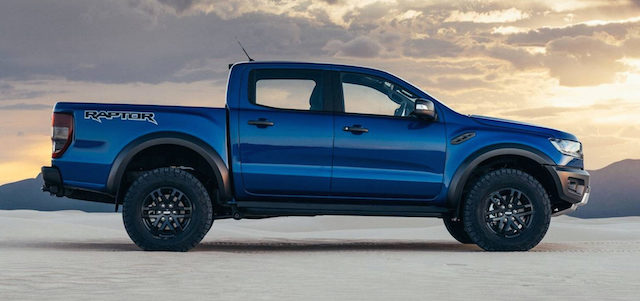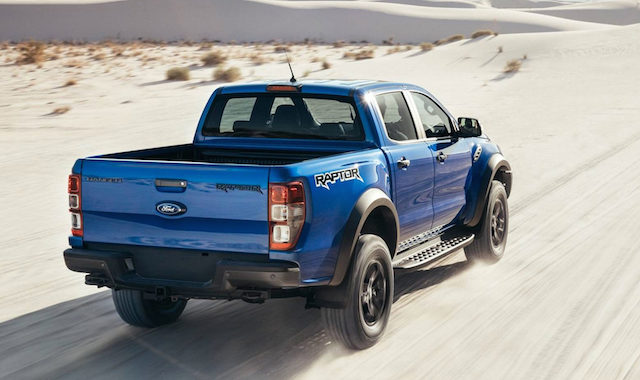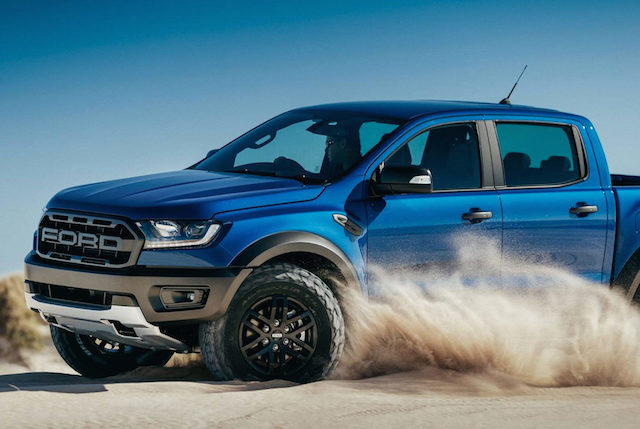
Hopes among Ford fans in New Zealand a year ago that the new Ranger Raptor double-cab ute would arrive in 2018 with a beefy all-American engine have been dashed – it gets a tweaked four-cylinder 2.0-litre diesel from the company’s commercial fleet, notably the Transit van.
But whereas the Transit unit is boosted by a single turbocharger, the Raptor engine gets dual turbos – a smaller one spinning up lower in the rev range and a larger one providing boost higher up. A large intercooler sits in front of the radiator.
The result is output of 157kW/500Nm to the rear wheels – or all four via a High-Low ratio mode – via a 10-speed automatic transmission with torque converter developed between Ford and rival General Motors for the updated 2018 Mustang and others.
Ranger Raptor gets six drive modes – Normal, Sport and Weather in rear-wheel drive, Mud/Sand and Baja (both High and Low 4WD) and Rock/Gravel (4WD Low only).
So how does Ranger Raptor power compare to that of the standard Asia-Pacific and US Rangers?
- Ranger as NZ knows it delivers 147kW/470Nm from its five-cylinder 3.2-litre diesel engine. Gearbox is a six-speed auto.
- Ranger for the US market delivers 208kW/415Nm from its four-cylinder 2.3-litre Ecoboost petrol engine. Gearbox is the 10-speeder.
Will a more powerful 2.3-litre unit go into the Ranger Raptor in the US, or will Ford go with a detuned version of the Ecoboost 3.5-litre V6 that powers the bigger F-150 Raptor?
A US Ranger Raptor is a given, Stateside observers say – but not with a diesel. An Australian photographer spying on Ford’s test ground west of Melbourne last year pictured a camouflaged Ranger Raptor with side-slung exhausts emitting what he said was the rorty sound of a big turbocharged petrol engine.
Interesting Twitter post in the past 48 hours from Ford’s North American communications boss Mike Levine, answering queries about a US Ranger Raptor: “Today’s announcement is about the launch of the new Ranger Raptor in Asia-Pacific markets. We’ll have more to say about Ranger Raptor at a later date.”
Ford unveiled the Asia-Pacific Ranger Raptor at its plant in Thailand, where it will be built alongside the standard Ranger. Its dimensions are bigger all-round: 330mm wider, 25mm taller, 9mm longer, and its track has been widened by 150mm at each end.
It’s tougher, too, thanks to strengthened chassis rails and extra reinforcement for the front and rear shock towers.
Up front, Raptor uses the same MacPherson strut suspension set-up as the regular Ranger, but gets longer springs and US-made Fox Racing shock absorbers.
The rear set-up has been reworked for improved stability. There’s a Watts link rear suspension with coilover springs for improved stability, Fox shocks, and rear disc brakes.
Ranger Raptor rides on 17-inch alloy rims fitted with 285/70 R17 all-terrain tyres from BF Goodrich. The tyre package raises the ute’s ride height to 283mm, 46mm higher than Ranger Wildtrak.
The Ranger Raptor is only rated to tow 2500kg – 1000kg less than the 3.2-litre Ranger with a braked trailer.
- Ranger Raptor will land in NZ later in the year. Price will be released closer to launch date.




